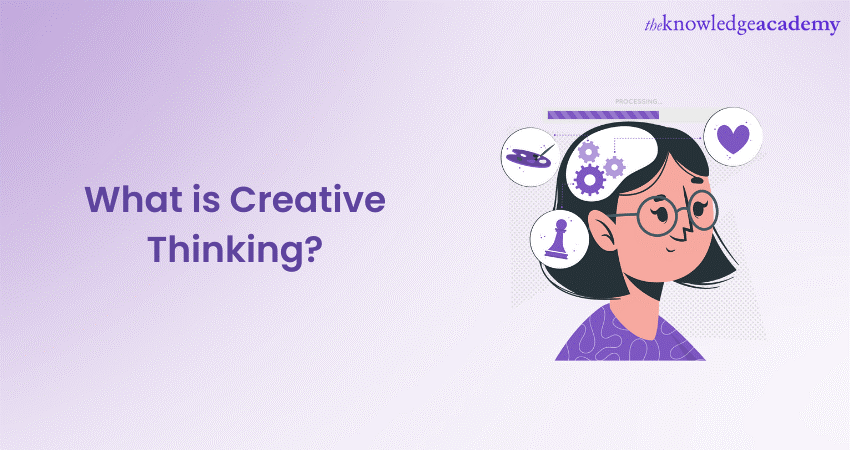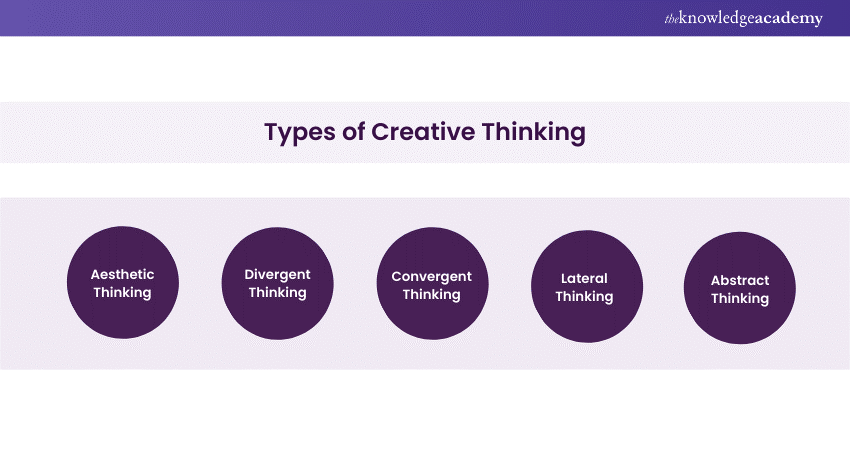We may not have the course you’re looking for. If you enquire or give us a call on 01344203999 and speak to our training experts, we may still be able to help with your training requirements.
Training Outcomes Within Your Budget!
We ensure quality, budget-alignment, and timely delivery by our expert instructors.

In a world constantly reshaped by innovation and imagination, the force driving these transformations is the power of Creative Thinking. But What is Creative Thinking exactly? At its core, it's the ability to perceive the world in new ways. It allows you to find hidden patterns and generate solutions and it's not just reserved for artists and inventors but is a crucial skill for everyone. Want to know how? Read this blog to learn about What is Creative Thinking, its features, examples, its importance as well as tips to unlock your Creative Thinking potential.
Table of Contents
1) Understanding What is Creative Thinking
2) Types of Creative Thinking
3) Importance of Creative Thinking
4) Benefits of Creative Thinking
5) Creative Thinking examples
6) Conclusion
Understanding What is Creative Thinking
Defining Creative Thinking is important before one chooses to explore its depth. Creative Thinking is a crucial aspect of Design Thinking, characterised as the capacity to perceive scenarios, ideas, or challenges in novel, innovative, and often unconventional manners. It necessitates surpassing established patterns or notions, leading to the creation of original and impactful ideas. At its core, it represents the act of venturing beyond conventional boundaries.
Types of Creative Thinking
After you have learned What is Creative Thinking, it’s time to understand its various types. Creative Thinking is multifaceted, and various types can be employed depending on the context or the problem at hand. Here are its five common types:

a) Divergent Thinking: This type of Thinking is about generating multiple solutions or ideas from a single starting point. It's similar to brainstorming, where the goal is to come up with as many answers or ideas as possible. Divergent Thinking is expansive, non-linear, and unrestrained, allowing for a wide array of potential solutions.
b) Convergent Thinking: Opposite to Divergent Thinking, Convergent Thinking seeks to narrow down options to find the single best solution to a problem. It involves analytical skills and logic to evaluate the ideas generated by divergent thinking, ultimately arriving at the most suitable answer.
c) Lateral Thinking: Coined by Edward de Bono, Lateral Thinking involves looking at a problem from a completely different perspective. It's about thinking "outside the box" and seeking solutions that might not be immediately obvious. Lateral thinkers often use indirect and creative approaches to problem-solving, making connections between seemingly unrelated concepts.
d) Abstract Thinking: This ability refers to the about concepts, ideas, or objects that are not physically present. It involves understanding complex ideas by breaking them down into their constituent parts and understanding how they relate to one another. Abstract thinkers are often good at seeing the "bigger picture" and understanding overarching themes and patterns.
e) Aesthetic Thinking: Rooted in the appreciation of beauty, art, and nature, Aesthetic Thinking is about recognising and creating harmony, balance, rhythm, and emotion. It's a form of Thinking often employed by artists, designers, musicians, and other creatives who seek to convey emotion, evoke reactions, or represent abstract ideas through their works.
Interested in building skills to guide those around you? Register for our Leadership Skills Courses!
Importance of Creative Thinking
In the contemporary job market, the enduring value of soft skills, such as Creative Thinking, extends across diverse industries. Employers increasingly prioritise adept at developing and experimenting with novel ideas. They actively seek analytical and outside-the-box thinkers, emphasising the iterative nature of Creative Thinking skills. These skills, encompassing creative problem-solving, innovative thinking, and analytical abilities, hold particular significance in workplaces marked by constant evolution and the integration of emerging technologies.
Creative Thinking is a linchpin in the contemporary professional landscape. With the rising importance of soft skills, including resilience, flexibility, agility, motivation, self-awareness, curiosity, and a commitment to lifelong learning, these attributes complement and amplify the impact of Creative Thinking. They reflecting the multifaceted nature of skills demanded in an ever-evolving workplace.
Thus, Creative Thinking is not confined to specific roles or industries but emerges as a cross-cutting competency essential for addressing the complexity of modern challenges. As workplaces grapple with rapid technological advancements and paradigm shifts, professionals with Creative Thinking skills stand out as valuable assets. Their ability to navigate challenges, devise innovative solutions, and adapt to changing market environments aligns with the demands of an era marked by continuous transformation.
Benefits of Creative Thinking
Embracing Creative Thinking isn't confined to professional realms; its transformative impact extends to various facets of life, want to know how?. Here are key benefits that underscore the value of nurturing Creative Thinking skills across personal, academic, and leadership domains:
Improved problem-solving capabilities
Creative Thinking is a versatile problem-solving tool, not limited to workplace challenges. It accelerates problem resolution by introducing diverse thought techniques. The cultivated ability to discern patterns more swiftly broadens the scope of effective solutions, promoting agility in addressing many issues encountered in daily life.
Stronger interpersonal connections
Enhanced communication lies at the heart of Creative Thinking's impact on relationships. Clear articulation of ideas enriches conversations with friends, family, and colleagues. Moreover, collaborative Creative Thinking fosters a collective approach to problem-solving. This, in turn, strengthens bonds and generating innovative solutions through the synergy of diverse perspectives.
Heightened productivity
Contrary to misconceptions, Creative Thinking is not a diversion but a catalyst for productivity. When traditional thought patterns lead to frustration and stagnation, engaging in Creative Thinking strategies becomes a rejuvenating pause. It rekindles motivation, reignites passion, and unlocks new solutions. As a result, it prevents productivity decline by introducing fresh perspectives and approaches.
Higher self-awareness
Creative Thinking acts as a vehicle for self-discovery by encouraging the exploration of diverse perspectives. This process unveils assumptions, biases, and viewpoints that may have remained unnoticed.
By challenging conventional thinking, it nurtures self-awareness and bolsters emotional intelligence. The ability to reframe perspectives and embrace a growth mindset becomes a decisive outcome of this ongoing journey of self-exploration.
Creative Thinking examples
Understanding a concept often becomes simpler when illustrated with tangible examples. To provide a clearer image of what Creative Thinking encompasses, let’s dive deeper into instances from diverse domains:
Art
Salvador Dali, a master of the surreal, gifts the world with his painting, "The Persistence of Memory". At first glance, the work can be disconcerting, with its limp watches draped eerily across a desolate land. But delve deeper, and it's evident that Dali challenges our understanding of time. The melted clocks aren’t just distortions; they're an invitation to view time not as a rigid construct but as a fluid entity. Dali’s work exemplifies how creative thinkers can challenge accepted norms and offer fresh, sometimes revolutionary perspectives.
Business
Apple's unveiling of the iPhone in 2007 was more than just the launch of a new product. While the market was saturated with phones that played music or accessed the internet, Apple's vision was different. They didn’t see these functions as separate entities but imagined a cohesive device that melded them together.
Converging an iPod, a phone, and an Internet communicator into a single device, Apple didn't just create a new product; they reinvented our understanding of what a phone could be. This disruptive innovation, born from a willingness to think differently, altered the trajectory of communication technology.
Problem-solving
Mistakes, in the creative world, are often seen as stepping stones rather than setbacks. A perfect illustration of this mindset is the invention of "Post-it Notes" by 3M. What started as a botched experiment in search of a robust adhesive led to the accidental discovery of a weak, repositionable one.
Where others might have seen failure, 3M spotted opportunity. Instead of discarding the discovery, they embraced its unique qualities, leading to the birth of the Post-it Note. Today, these sticky notes, borne from an unintentional finding, adorn offices, homes, and schools worldwide, reminding us that sometimes thinking creatively means recognising the potential in the unexpected.
Learn to be a dignified figure among your peers by joining our Introduction to Supervising a Team Course!
Conclusion
While asking the question “What is Creative Thinking?", remember that the answer goes beyond just understanding innovation. It delves into the profound realisation of our potential to transform and innovate. As illustrated by numerous examples, such thinking can revolutionise sectors, tackle immense challenges, and enhance personal growth. When confronted with a challenge, embrace this powerful mindset to harness your mind's vast capabilities.
Curious about how the human mind works? Try our Creative and Analytical Thinking Training!
Frequently Asked Questions

To enhance Creative Thinking skills, engage in activities outside your comfort zone, embrace diverse perspectives, and regularly challenge assumptions. Practice brainstorming without self-censorship, explore new hobbies and seek inspiration from various sources. Cultivate a mindset of curiosity and continuous learning, fostering a creative approach to problem-solving

Creative Thinking provides a competitive edge in the job market by enabling innovative problem-solving, fostering adaptability, and enhancing communication skills. Employers value candidates who bring fresh perspectives to challenges, driving creativity and efficiency.

Certifications targeting Creative Thinking offer creativity, innovation, and problem-solving capabilities. While not certifications per se, courses can provide valuable skills and perspectives to strengthen your creative thinking abilities.

The Knowledge Academy takes global learning to new heights, offering over 30,000 online courses across 490+ locations in 220 countries. This expansive reach ensures accessibility and convenience for learners worldwide.
Alongside our diverse Online Course Catalogue, encompassing 17 major categories, we go the extra mile by providing a plethora of free educational Online Resources like News updates, blogs, videos, webinars, and interview questions. Tailoring learning experiences further, professionals can maximise value with customisable Course Bundles of TKA.

The Knowledge Academy’s Knowledge Pass, a prepaid voucher, adds another layer of flexibility, allowing course bookings over a 12-month period. Join us on a journey where education knows no bounds.

The Knowledge Academy offers various Leadership courses, including Leadership Skills Training and Agile Leadership Course. These courses cater to different skill levels, providing comprehensive insights into Leadership Qualities.
Our Leadership Skills blogs cover a range of topics related to Leadership, offering valuable resources, best practices, and industry insights. Whether you are a beginner or looking to advance your Leadership skills, The Knowledge Academy's diverse courses and informative blogs have you covered.
Upcoming Business Skills Resources Batches & Dates
Date
 Successful People Management and Team Leadership
Successful People Management and Team Leadership
Fri 7th Jun 2024
Fri 2nd Aug 2024
Fri 4th Oct 2024
Fri 6th Dec 2024







 Top Rated Course
Top Rated Course




 If you wish to make any changes to your course, please
If you wish to make any changes to your course, please


